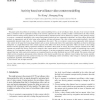Free Online Productivity Tools
i2Speak
i2Symbol
i2OCR
iTex2Img
iWeb2Print
iWeb2Shot
i2Type
iPdf2Split
iPdf2Merge
i2Bopomofo
i2Arabic
i2Style
i2Image
i2PDF
iLatex2Rtf
Sci2ools
PR
2008
2008
Activity based surveillance video content modelling
This paper tackles the problem of surveillance video content modelling. Given a set of surveillance videos, the aims of our work are twofold: firstly a continuous video is segmented according to the activities captured in the video; secondly a model is constructed for the video content, based on which an unseen activity pattern can be recognised and any unusual activities can be detected. To segment a video based on activity, we propose a semantically meaningful video content representation method and two segmentation algorithms, one being offline offering high accuracy in segmentation, and the other being online enabling real-time performance. Our video content representation method is based on automatically detected visual events (i.e. `what is happening in the scene'). This is in contrast to most previous approaches which represent video content at the signal level using image features such as colour, motion and texture. Our segmentation algorithms are based on detecting break...
| Added | 14 Dec 2010 |
| Updated | 14 Dec 2010 |
| Type | Journal |
| Year | 2008 |
| Where | PR |
| Authors | Tao Xiang, Shaogang Gong |
Comments (0)

